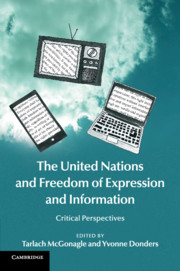16 results
17 - A Draft Obituary for the Offence of Blasphemy in Ireland
- from Part VI - Dormant Blasphemy Laws
-
-
- Book:
- Blasphemy and Freedom of Expression
- Published online:
- 13 November 2017
- Print publication:
- 16 November 2017, pp 456-479
-
- Chapter
- Export citation
Frontispiece
-
- Book:
- The United Nations and Freedom of Expression and Information
- Published online:
- 05 June 2015
- Print publication:
- 11 June 2015, pp ii-ii
-
- Chapter
- Export citation
Part I - UN normative and institutional approaches to the protection of freedom of expression and information
-
- Book:
- The United Nations and Freedom of Expression and Information
- Published online:
- 05 June 2015
- Print publication:
- 11 June 2015, pp 53-268
-
- Chapter
- Export citation
Dedication and Appreciation
-
- Book:
- The United Nations and Freedom of Expression and Information
- Published online:
- 05 June 2015
- Print publication:
- 11 June 2015, pp vii-xii
-
- Chapter
- Export citation
Copyright page
-
- Book:
- The United Nations and Freedom of Expression and Information
- Published online:
- 05 June 2015
- Print publication:
- 11 June 2015, pp iv-iv
-
- Chapter
- Export citation
Notes on Contributors
-
- Book:
- The United Nations and Freedom of Expression and Information
- Published online:
- 05 June 2015
- Print publication:
- 11 June 2015, pp xiii-xix
-
- Chapter
- Export citation
Foreword
-
- Book:
- The United Nations and Freedom of Expression and Information
- Published online:
- 05 June 2015
- Print publication:
- 11 June 2015, pp xx-xxi
-
- Chapter
- Export citation
Acknowledgements
-
- Book:
- The United Nations and Freedom of Expression and Information
- Published online:
- 05 June 2015
- Print publication:
- 11 June 2015, pp xxiv-xxiv
-
- Chapter
- Export citation
Appendices
-
- Book:
- The United Nations and Freedom of Expression and Information
- Published online:
- 05 June 2015
- Print publication:
- 11 June 2015, pp 466-483
-
- Chapter
- Export citation
Contents
-
- Book:
- The United Nations and Freedom of Expression and Information
- Published online:
- 05 June 2015
- Print publication:
- 11 June 2015, pp v-vi
-
- Chapter
- Export citation
Index
-
- Book:
- The United Nations and Freedom of Expression and Information
- Published online:
- 05 June 2015
- Print publication:
- 11 June 2015, pp 484-508
-
- Chapter
- Export citation
Part II - Selected thematic focuses
-
- Book:
- The United Nations and Freedom of Expression and Information
- Published online:
- 05 June 2015
- Print publication:
- 11 June 2015, pp 269-465
-
- Chapter
- Export citation
1 - The development of freedom of expression and information within the UN: leaps and bounds or fits and starts?
-
-
- Book:
- The United Nations and Freedom of Expression and Information
- Published online:
- 05 June 2015
- Print publication:
- 11 June 2015, pp 1-52
-
- Chapter
- Export citation
Glossary
-
- Book:
- The United Nations and Freedom of Expression and Information
- Published online:
- 05 June 2015
- Print publication:
- 11 June 2015, pp xxii-xxiii
-
- Chapter
- Export citation

The United Nations and Freedom of Expression and Information
- Critical Perspectives
-
- Published online:
- 05 June 2015
- Print publication:
- 11 June 2015
24 - A Survey and Critical Analysis of Council of Europe Strategies for Countering “Hate Speech”
-
-
- Book:
- The Content and Context of Hate Speech
- Published online:
- 05 June 2012
- Print publication:
- 09 April 2012, pp 456-498
-
- Chapter
- Export citation



